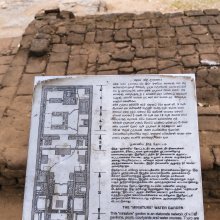Nir: 11 definitions
Introduction:
Nir means something in Hinduism, Sanskrit, the history of ancient India, Marathi, biology, Tamil. If you want to know the exact meaning, history, etymology or English translation of this term then check out the descriptions on this page. Add your comment or reference to a book if you want to contribute to this summary article.
Images (photo gallery)
India history and geography
Source: academia.edu: Minor Chiefs and "Hero" in Ancient TamilakamNīr (“water”) is a name related to the historical geography and rulers of ancient Tamil Nadu, occuring in Sangam literature such as the Akanāṉūṟu and the Puṟanāṉūṟu.—Notes: (VIS 400-402)

The history of India traces the identification of countries, villages, towns and other regions of India, as well as mythology, zoology, royal dynasties, rulers, tribes, local festivities and traditions and regional languages. Ancient India enjoyed religious freedom and encourages the path of Dharma, a concept common to Buddhism, Hinduism, and Jainism.
Biology (plants and animals)
Source: Wisdom Library: Local Names of Plants and DrugsNir [नीर] in the Nepali language is the name of a plant identified with Indigofera atropurpurea Hornem. from the Fabaceae (Pea) family having the following synonyms: Indigofera cavaleriei. For the possible medicinal usage of nir, you can check this page for potential sources and references, although be aware that any some or none of the side-effects may not be mentioned here, wether they be harmful or beneficial to health.
Source: Google Books: CRC World Dictionary (Regional names)1) Nir in India is the name of a plant defined with Nymphaea capensis in various botanical sources. This page contains potential references in Ayurveda, modern medicine, and other folk traditions or local practices It has the synonym Nymphaea emirnensis Planch. (among others).
2) Nir in Nepal is also identified with Bidens pilosa It has the synonym Coreopsis leucantha L. (etc.).
Example references for further research on medicinal uses or toxicity (see latin names for full list):
· Proceedings of the Indian Science Congress Association (1993)
· J. Cytol. Genet. (1971)
· Catalogus plantarum cubensium (1866)
· Meth. (1794)
· Journal of Japanese Botany (1981)
· Beitrage zur Flora der Cap Verdischen Inseln (1852)
If you are looking for specific details regarding Nir, for example health benefits, side effects, extract dosage, pregnancy safety, diet and recipes, chemical composition, have a look at these references.

This sections includes definitions from the five kingdoms of living things: Animals, Plants, Fungi, Protists and Monera. It will include both the official binomial nomenclature (scientific names usually in Latin) as well as regional spellings and variants.
Languages of India and abroad
Marathi-English dictionary
Source: DDSA: The Molesworth Marathi and English Dictionarynir (निर्).—S A particle and prefix implying I. Certainty or assurance. II. Negation or privation.
Marathi is an Indo-European language having over 70 million native speakers people in (predominantly) Maharashtra India. Marathi, like many other Indo-Aryan languages, evolved from early forms of Prakrit, which itself is a subset of Sanskrit, one of the most ancient languages of the world.
Sanskrit dictionary
Source: DDSA: The practical Sanskrit-English dictionaryNir (निर्).—ind. A substitute for निस् (nis) before vowels and soft consonants conveying the senses of 'out of', 'away from'. 'without', 'free from', and be frequently expressed by 'less', 'un', used with the noun; see the compounds given below; see निस् (nis) and cf. अ (a) also.
Source: Cologne Digital Sanskrit Dictionaries: Shabda-Sagara Sanskrit-English DictionaryNir (निर्).—ind. 1. A particle and prefix implying certainty, assurance. 2. Negation, privation. 2. Outside, out, without, forth. E. nṝ to guide, affix kvip.
Source: Cologne Digital Sanskrit Dictionaries: Monier-Williams Sanskrit-English Dictionary1) Nir (निर्):—[from niḥ] for nis (q.v.) before vowels and soft consonants.
2) Nīr (नीर्):—(ni-√īr), [Causal] (only [imperfect tense] nyairayat), to hurl down upon ([locative case]), [Ṛg-veda vi, 56, 3] (cf. ny-er).
Source: Cologne Digital Sanskrit Dictionaries: Yates Sanskrit-English DictionaryNir (निर्):—prep. Out, without, forth.
Source: DDSA: Paia-sadda-mahannavo; a comprehensive Prakrit Hindi dictionary (S)Nir (निर्) in the Sanskrit language is related to the Prakrit word: Ṇi.
Sanskrit, also spelled संस्कृतम् (saṃskṛtam), is an ancient language of India commonly seen as the grandmother of the Indo-European language family (even English!). Closely allied with Prakrit and Pali, Sanskrit is more exhaustive in both grammar and terms and has the most extensive collection of literature in the world, greatly surpassing its sister-languages Greek and Latin.
Kannada-English dictionary
Source: Alar: Kannada-English corpusNīr (ನೀರ್):—
1) [noun] the liquid that descends from the clouds as rain, forms streams, lakes, and seas, and is a major constituent of all living matter and that when pure is an odourless, tasteless, very slightly compressible liquid; water.
2) [noun] anything liquid containing or resembling water.
3) [noun] a watery fluid (as tears, sweat, urine or semen) formed or circulating in a living body.
4) [noun] the ocean or a sea.
5) [noun] the act of washing the body in water; bath.
6) [noun] the lustre of precious stones as diamond, pearl, etc.
7) [noun] vigour; vitality; sap.
8) [noun] dampness; moisture.
Kannada is a Dravidian language (as opposed to the Indo-European language family) mainly spoken in the southwestern region of India.
Tamil dictionary
Source: DDSA: University of Madras: Tamil LexiconNīr (நீர்) noun cf. nīra.
1. [K. nīr.] Water, one of the five elements; ஜலம். தீமுரணிய நீரும் [jalam. thimuraniya nirum] (புறநானூறு [purananuru] 2).
2. Sea, ocean; கடல். நீரொலித்தன்ன [kadal. nirolithanna] (பத்துப்பாட்டு: மதுரைக்காஞ்சி [pathuppattu: mathuraikkanchi] 369).
3. Juice, liquor; இரசம். கரும் பினை . . . யிடித்துநீர் கொள்ளினும் [irasam. karum pinai . . . yidithunir kollinum] (நாலடியார் [naladiyar], 156).
4. Rosewater; பனிநீர். நீரால் வெண்ணிறப்பொடியை மாற்றி [paninir. niral vennirappodiyai marri] (சீவகசிந்தாமணி [sivagasindamani] 117).
5. Humours of the body, as serum, lymph; உடலில் உள்ள இரத்தம் பித்தநீர் முதலிய திரவபதார்த்தம். [udalil ulla iratham pithanir muthaliya thiravapathartham.] (W.)
6. Urine; மூத்திரம். இவ்வெல்லையி னீர்பெய்து யான் வருகாறும் [muthiram. ivvellaiyi nirpeythu yan varugarum] (பிரமோத்தரகாண்டம் [piramotharagandam] 2, 50).
7. cf. நீர்நாள். [nirnal.] The 20th nakṣatra. See பூராடம். (பிங்கலகண்டு) [puradam. (pingalagandu)]
8. The 25th nakṣatra. See பூரட்டாதி. (அகராதி நிகண்டு) [purattathi. (agarathi nigandu)]
9. Dampness, moisture, humidity; ஈரம். [iram.] (W.)
10. Water in a gem; இரத்தினத்தின் ஒளி. நெடுநீர் வார்குழை [irathinathin oli. nedunir varkuzhai] (பத்துப்பாட்டு: நெடு [pathuppattu: nedu] 139).
11. Nature, disposition; குணம். அன்ன நீரார்க்கே யுள [kunam. anna nirarkke yula] (திருக்குறள் [thirukkural], 527).
12. State, condition; நிலை. [nilai.] (W.)
--- OR ---
Nīr (நீர்) [nīrttal] 11 intransitive verb < நீர்¹. [nir¹.]
1. To become thin or watery, as liquid food in cooking; நீராதல். [nirathal.]
2. To be wet, moist; ஈரமாதல். நீர்க்கின்ற செஞ்சடை [iramathal. nirkkinra senchadai] (திருமந். [thiruman.] 2121).
--- OR ---
Nīr (நீர்) pronominal See நீயிர். [niyir.] (நன். [nan.] 285.)
Tamil is an ancient language of India from the Dravidian family spoken by roughly 250 million people mainly in southern India and Sri Lanka.
See also (Relevant definitions)
Starts with (+4270): Nairiti, Nergal, Nibryaja, Nidrrava, Nidrravakarana, Nidrvamdvabhava, Nidrvamdvaka, Nidrvaya, Nir jiluga, Nir kadambu, Nir maruth, Nir nochi, Nir perzha, Nir-alari, Nir-amparkatti, Nir-atarkay, Nir-atarparuvam, Nir-atarpatam, Nir-atimuttu, Nir-avimantapam.
Ends with (+197): Akkininir, Alinir, Alukaikkannir, Ampunir, Anantakkannir, Anir, Annanir, Arakkunir, Arambunir, Aranir, Arumbunir, Arunir, Atai-ottinir, Avecanir, Avinir, Ayininir, Balinir, Baynir, Beccunir, Bennir.
Full-text (+2802): Nirvaha, Nirvega, Nirvarnana, Nirudyoga, Nirvivara, Muttunir, Nirnamaskara, Nirakula, Nirguna, Nirvishta, Nirashis, Avinir, Nirkkuttal, Nirnetritva, Nirppinakku, Niraksha, Niraticaram, Nirpirital, Otinanir, Vintunir.
Relevant text
Search found 41 books and stories containing Nir, Nīr, Neer; (plurals include: Nirs, Nīrs, Neers). You can also click to the full overview containing English textual excerpts. Below are direct links for the most relevant articles:
Tiruvaymoli (Thiruvaimozhi): English translation (by S. Satyamurthi Ayyangar)
Pasuram 6.5.3 < [Section 5 - Fifth Tiruvaymoli (Tuval il ma mani matam)]
Pasuram 6.5.2 < [Section 5 - Fifth Tiruvaymoli (Tuval il ma mani matam)]
Pasuram 4.6.2 < [Section 6 - Sixth Tiruvaymoli (Tirpparai yam ini)]
Folk Tales of Gujarat (and Jhaverchand Meghani) (by Vandana P. Soni)
Chapter 23 - Gor Gorani Ni Tikhal < [Part 3 - Kankavati]
Chapter 20 - Nir Jal Mas < [Part 3 - Kankavati]
Chapter 7c - Gigo Mahiyo < [Part 2 - Sorathi Baharvatiya]
Rig Veda (translation and commentary) (by H. H. Wilson)
Sahitya-kaumudi by Baladeva Vidyabhushana (by Gaurapada Dāsa)
Text 10.145 < [Chapter 10 - Ornaments of Meaning]
Shrimad Bhagavad-gita (by Narayana Gosvami)
Verse 2.71 < [Chapter 2 - Sāṅkhya-yoga (Yoga through distinguishing the Soul from the Body)]
Verses 12.13-14 < [Chapter 12 - Bhakti-yoga (Yoga through Pure Devotional Service)]
The Markandeya Purana (by Frederick Eden Pargiter)



